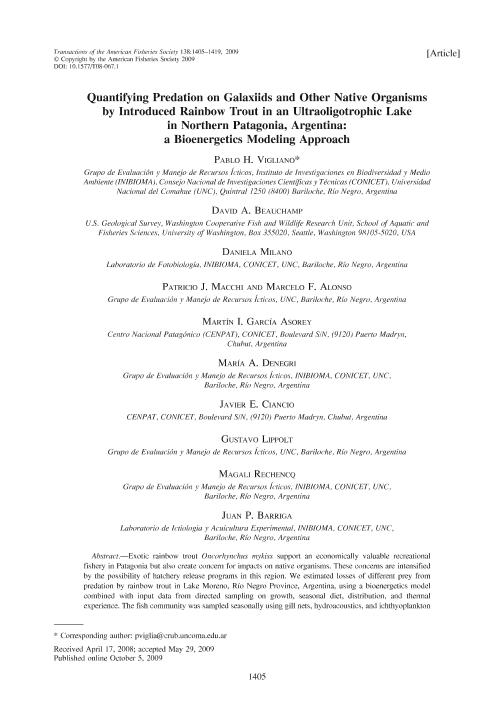Artículo
Quantifying predation on galaxiids and other native organisms by introduced rainbow trout in an ultraoligotrophic lake in northern Patagonia, Argentina: A bioenergetics modeling approach
Vigliano, Pablo Horacio; Beauchamp, David; Milano, Daniela ; Macchi, Patricio Jorge; Alonso, Marcelo Fabián; Garcia Asorey, Martin Ignacio
; Macchi, Patricio Jorge; Alonso, Marcelo Fabián; Garcia Asorey, Martin Ignacio ; Denegri, Maria Amalia
; Denegri, Maria Amalia ; Ciancio Blanc, Javier Ernesto
; Ciancio Blanc, Javier Ernesto ; Lippolt, Gustavo; Rechencq, Magali
; Lippolt, Gustavo; Rechencq, Magali ; Barriga, Juan Pablo
; Barriga, Juan Pablo
 ; Macchi, Patricio Jorge; Alonso, Marcelo Fabián; Garcia Asorey, Martin Ignacio
; Macchi, Patricio Jorge; Alonso, Marcelo Fabián; Garcia Asorey, Martin Ignacio ; Denegri, Maria Amalia
; Denegri, Maria Amalia ; Ciancio Blanc, Javier Ernesto
; Ciancio Blanc, Javier Ernesto ; Lippolt, Gustavo; Rechencq, Magali
; Lippolt, Gustavo; Rechencq, Magali ; Barriga, Juan Pablo
; Barriga, Juan Pablo
Fecha de publicación:
05/2009
Editorial:
American Fisheries Society
Revista:
Transactions Of The American Fisheries Society
ISSN:
0002-8487
Idioma:
Inglés
Tipo de recurso:
Artículo publicado
Clasificación temática:
Resumen
Exotic rainbow trout Oncorhynchus mykiss support an economically valuable recreational fishery in Patagonia but also create concern for impacts on native organisms. These concerns are intensified by the possibility of hatchery release programs in this region. We estimated losses of different prey from predation by rainbow trout in Lake Moreno, Río Negro Province, Argentina, using a bioenergetics model combined with input data from directed sampling on growth, seasonal diet, distribution, and thermal experience. The fish community was sampled seasonally using gill nets, hydroacoustics, and ichthyoplankton nets. Pelagic galaxiid larvae and benthic juvenile and adult small puyen Galaxias maculatus were the most important components of the diet. Bioenergetics simulations showed that over a 6-year life span in the lake (ages 1-7), rainbow trout attained a body mass of 2.3 kg and consumed 74.7 kg of food, of which 20% consisted of galaxiid larvae and 16% consisted of adult small puyen. Based on an estimated abundance of 29,000 rainbow trout of ages 1-7, this predator exerted significant but sustainable mortality on the native prey populations, consuming 44 metric tons or an estimated 23% of the annual larval galaxiid production and 35 metric tons of adult small puyen, which represented an unknown fraction of the postlarval population. Galaxiids supported the estimated predation demand under current conditions. However, simulations of stocking strategies normally proposed for this region showed that consumption demands on prey would increase to unsustainable levels, reducing native fish populations and likely reducing growth of rainbow trout. It is also probable that the fish community composition would shift further in response to the increased demand for prey by stocked predators. This implies that in some cases, stocking could jeopardize sport fisheries; stocking strategies should be evaluated on a case-by-case basis to be consistent with specific objectives for native fish conservation and sustainable food web interactions.
Palabras clave:
salmonid introduced
,
galaxiids
,
predation
,
bioenergetic
Archivos asociados
Licencia
Identificadores
Colecciones
Articulos(CCT-CENPAT)
Articulos de CTRO.CIENTIFICO TECNOL.CONICET - CENPAT
Articulos de CTRO.CIENTIFICO TECNOL.CONICET - CENPAT
Articulos(INIBIOMA)
Articulos de INST. DE INVEST.EN BIODIVERSIDAD Y MEDIOAMBIENTE
Articulos de INST. DE INVEST.EN BIODIVERSIDAD Y MEDIOAMBIENTE
Citación
Vigliano, Pablo Horacio; Beauchamp, David; Milano, Daniela; Macchi, Patricio Jorge; Alonso, Marcelo Fabián; et al.; Quantifying predation on galaxiids and other native organisms by introduced rainbow trout in an ultraoligotrophic lake in northern Patagonia, Argentina: A bioenergetics modeling approach; American Fisheries Society; Transactions Of The American Fisheries Society; 138; 6; 5-2009; 1405-1419
Compartir
Altmétricas



